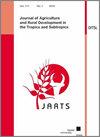Tillage system and integrated soil fertility inputs improve smallholder farmers’ soil fertility and maize productivity in the Central Highlands of Kenya
Q3 Social Sciences
Journal of Agriculture and Rural Development in the Tropics and Subtropics
Pub Date : 2021-09-20
DOI:10.17170/KOBRA-202107134319
引用次数: 5
Abstract
We designed and implemented an on-farm trial in Meru South and Gatanga sub-counties to understand the effects of integrated soil fertility management (ISFM) technologies on soil nitrogen (N), phosphorus (P), potassium (K), and maize productivity. The technologies included combinations of mineral fertiliser and maize stover (CrMf); crop residue, Tithonia diversifolia and rock phosphate (CrTiP); crop residue, Tithonia diversifolia and goat manure (CrTiMan); crop residue, inorganic fertiliser and goat manure (CrMfMan); crop residue, goat manure and Dolichos lablab (CrManLeg), and sole inorganic fertiliser (Mf) executed under conventional (ConC) and minimum (MinTill) tillage methods. We interviewed the farmers who participated in implementing the trials at the end of the study to understand the likelihood to uptake the technologies. We observed that the technologies increased soil N, P, K, and maize productivity compared to ConC (the control). There was a high likelihood of uptake of high-performing ISFM technologies. We recommend CrTiP for the two sub-counties for the short-term. However, a long-term experiment is needed to evaluate performances of CrTiMan, CrTiP, CrMfMan, and CrManLeg under the two tillage methods for site-specific recommendations taking into consideration rainfall variations.耕作系统和综合土壤肥力投入提高了肯尼亚中部高地小农的土壤肥力和玉米生产力
我们在梅鲁南部和加坦加县设计并实施了一项田间试验,以了解综合土壤肥力管理(ISFM)技术对土壤氮(N)、磷(P)、钾(K)和玉米生产力的影响。这些技术包括矿物肥料和玉米秸秆(CrMf)的组合;作物残留物、香和磷酸岩(CrTiP);作物残留物、香和羊粪(CrTiMan);作物残渣、无机肥料和羊粪(CrMfMan);作物残渣、羊粪和Dolichos实验室(CrManLeg),以及在传统(ConC)和最低(MinTill)耕作方法下施用的唯一无机肥料(Mf)。我们采访了在研究结束时参与实施试验的农民,以了解他们采用这些技术的可能性。我们观察到,与ConC(对照)相比,这些技术提高了土壤氮、磷、钾和玉米的生产力。采用高性能ISFM技术的可能性很高。我们建议这两个子县短期使用CrTiP。然而,需要进行长期实验来评估CrTiMan、CrTiP、CrMfMan和CrManLeg在两种耕作方法下的性能,以便在考虑降雨量变化的情况下提出特定地点的建议。
本文章由计算机程序翻译,如有差异,请以英文原文为准。
求助全文
约1分钟内获得全文
求助全文
来源期刊
CiteScore
2.30
自引率
0.00%
发文量
0
审稿时长
>36 weeks
期刊介绍:
The Journal of Agriculture and Rural Development in the Tropics and Subtropics publishes papers dealing with original research and review papers in the fields of plant production, animal nutrition and animal husbandry, soil science, rural economy and farm management, forestry and forest economy, veterinary hygiene and protection against epidemics.

 求助内容:
求助内容: 应助结果提醒方式:
应助结果提醒方式:


